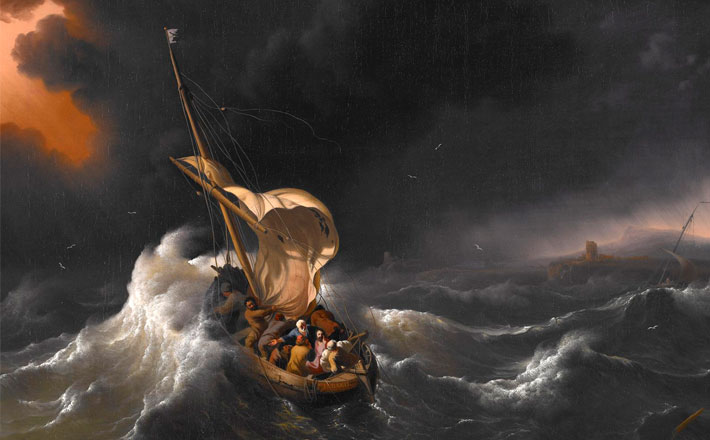Commentary on Mark 4:35-41
“On that day.” The phrase is so brief the reader could almost ignore it.
Actually, this short transition is vastly important for setting the stage for this familiar story of the stilling of the storm. In the order of the original Greek, the text would read “and he continued to speak to them on that day … ” The important effect is to remind us that this story comes right on the heels of all of Jesus’ special teaching to his disciples on the nature of the kingdom — on his characterization of that kingdom as couched in hiddenness and secrecy, and of its requiring a special gift of hearing to comprehend. So it should not surprise us if the journey of discipleship, and the course of our journeys in this Pentecost season should at times be fraught with unexpected dangers or risks.
A Parable of Discipleship
Many readers have called attention to the way in which this story of the stilling of the storm can be read on several levels. On one level it shows Jesus power in a miracle that joins all the miracles of healing in Mark’s opening chapters. On another level it might serve as a parable of discipleship. We begin with a call or invitation that mirrors Jesus’ call of his first disciples to follow him (Mark 1:16-20) — “Let us go across to the other side” — a command to which his disciples obediently respond, significantly in the language of the story “taking him along with them in the boat” (vv. 35-36). At this point it is not difficult to imagine the scene as recalling the ark adrift on the chaos of the sea, but now presenting a band of followers under the protection of God’s Messiah, “safe and secure from all alarms.”
But events change suddenly. Out of the blue, so to speak, with no textual transition we read: “And there happens! a great windstorm and the waves began to beat against the boat so that the boat was already filling with water.” So much for implied safety of the boat (4 times in this we have already heard about this “boat”).
Do You Not Care?
Meanwhile “he” (not Jesus, is the indefinite reference significant?) is in the stern (the place where perhaps he should be steering?) sleeping away peacefully on a pillow! (taking his leisure oblivious to the predicament). And “they” (they are not at this point referred to as disciples) awake him and shout, “Teacher (not Master, or Messiah, or “Lord,” as in Matthew 8:25) do you not care that we are perishing?”
Their cry is the ultimate cry of fear, of doubt and abandonment, repeated often in the stories of God’s people, as for example in the psalms. Where is God in the midst of my distress? Has God abandoned his people? It is a cry repeated in so many ways in the midst of the terrors and distresses of our world today. If God is so great and powerful a creator, if God really cares about this world, then why do events in the world and in my life go so badly. The ready response: either God has no power, or God does not care for us or the creation.
We Are Perishing
This is an honest appraisal of the situation in the story, and a parable of the situation of all of us when cast adrift in the storms of the world without God’s presence and care. The cry amounts to a prayer for deliverance. And it is immediately and directly answered. Jesus does not chastise or reason with their fears. He does not seek to correct their poor theology or remind them of the whole tradition of God’s deliverance and care for the people of Israel. (in contrast to Matthew’s narrative in which Jesus’ first critiques the disciples’ lack of faith, 8:26). Instead he immediately “woke up” (the word is actually “arose” and may here be a telling and parabolic clue to the end of this story?) and rebuked the winds forcefully with his double command: “Be silent! Be still! The response of the winds is immediate. The wind ceased and there arose a “great calm” (the description of this “great calm” exactly matches and counters the “great storm” which has begun the predicament (vv. 37, 39).
The Thin Line of Fear and Faith
But now that the rescue is accomplished and the sea is calm, there is time for some needed disciple instruction. Like with the parables that have gone before, now Jesus moves to “interpret” this yet one more “parable” for disciples whose capacities are weak without the gift of their master’s presence and care.
The Lord’s care has already been demonstrated. Of this there is no need for greater elaboration at this point. The issue is that of “fear.” In Jesus’ question “Have you yet no faith,” the disciples in the story, and we as its hearers today, are called to recognition between two vastly different worlds that we might inhabit. In these two words we are called to see the gulf between two vastly different worlds that face those who are called to acknowledge the kingdom of God, the presence and rule of God in our midst. One can continue to live in the world of fear and chaos, seeing oneself orphaned or alone without the power of God, living in a world controlled by the power of satan or the demonic. Or one can be open to hearing the message and promise of this Jesus in whom we are told that the kingdom of God has come into our midst and now offers a whole new future for our world and for our lives.
The line between these two worlds is thin and risky. But in between them stands the gift and power of the good news of God’s Messiah, Jesus.
Who Then is This?
So at the end of the story, the great question of this “parable” of discipleship is placed in our laps. The disciples ask “Who then is this?” (vs. 41) Their question is described as one of “great fear,” (literally, “they feared a great fear;” interestingly the same words that describe the shepherds response to the angel at Jesus’ birth in Luke 2:9), or as the NRSV has correctly sensed it, “great awe.” When God comes among us, how will we respond? In the story, no answer is given to the disciples’ question. The question of how we will respond to this Jesus, whom “even the wind and the sea obey” is left open. There is time for the answer to mature in the hearing of the rest of the story; just as there is time for that answer to take shape in our lives as we journey with this Jesus in the season of Pentecost. Perhaps in the shaping of that journey the power and presence of the good news of God’s kingdom will shape our lives in the crucial turn from fear to faith. This is the great “turning” which goes by the name of repentance, which is the call and promise of Jesus at the beginning of Mark’s gospel (Mark 1:14-15).


June 21, 2015